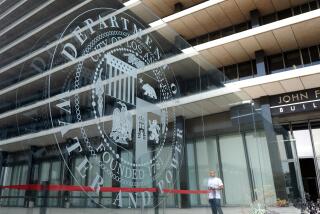A âTrickâ on County, a âTreatâ for Lawyers
Trick or treat? Halloween arrived early this year for the county when, in August, the law firm of Hennigan, Mercer & Bennett shocked legal representatives by demanding a âtreatâ of $48.7 million. Surprised that the firm would seek a bonus nearly twice as large as the $26.3 million in legal fees already collected, county officials questioned how this bonus could be anything other than an illegal gift of public funds.
The firm revealed the âtrickâ--a vague, open-ended clause that appears to grant it latitude to draft a final fee statement, charging unspecified amounts above and beyond âbenchmark billing rates.â The bankruptcy litigation representative, Thomas W. Hayes, denied the claim, declaring further payments âunnecessary.â The firm sued its former clients in federal court for $48.7 million. A decision rests with U.S. District Judge Gary L. Taylor, who fielded arguments from both sides on Oct. 7.
This is the law firm that on behalf of the county (and pool investors) had banged on doors up and down Wall Street, suing and successfully âscaringâ several financial firms into settlements, ultimately bagging $865 million. While an impressive sum, it is important to note that $865 million is just over half the amount of investment losses suffered by the Orange County investment pool in 1994, which led to the countyâs bankruptcy. If Taylor awards the $48.7 million or any additional money to the lawyers, the award will reduce recovery payments to local governments. Such a decision would enrich Hennigan, Mercer & Bennett for naming and claiming their bonus at public expense. An award in this case could set a dangerous precedent.
J. Michael Hennigan, a partner, called the bonus reasonable, saying that most contingency arrangements provide much more than the $75 million, or less than 10% of recovered amounts, that his firm would receive. âIt is a huge number, but well-deserved, I think,â Hennigan concluded.
But what of the original intent of the parties to this agreement? In particular, the county, seeking to avoid a contingency arrangement, agreed to pay the firmâs listed rates for legal services and earlier had set aside a $50-million âwar chestâ to fund the legal effort: There was no risk that the law firm would not be paid in a timely way. One might consider the $385 to $450 hourly rate, billed by partners at HMB, sometimes for hundreds of hours per month, to be adequate compensation.
Should we be bound by the âtrickâ and provide the âtreatâ? Are fully compensated law firms entitled to a retroactive contingency in such cases? An expansive interpretation of the terms of an agreement, particularly by the party that drafted it, often meets with judicial skepticism. That would be particularly appropriate and welcome in this case.
More to Read
Sign up for Essential California
The most important California stories and recommendations in your inbox every morning.
You may occasionally receive promotional content from the Los Angeles Times.










